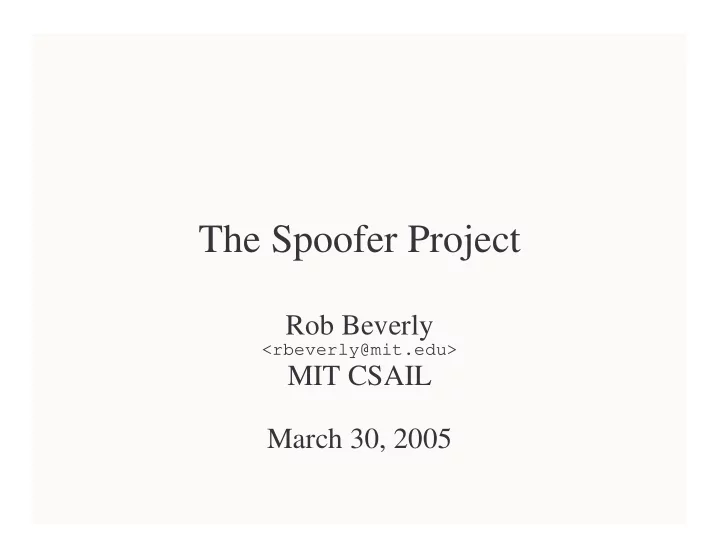

The Spoofer Project Rob Beverly <rbeverly@mit.edu> MIT CSAIL March 30, 2005
Spoofer Project Background • High-profile spoofing-based DDoS attacks in 2000, 2001 • Does spoofing really matter in 2005? – All ISP filter, right? – Zombie Farms – NAT Rewriting • But: – Reflector attacks – Backscatter shows continued spoofing
Spoofer Project • http://momo.lcs.mit.edu/spoofer • Active measurement project • Clients run our program (binaries, source) • Availability advertised to e.g. NANOG mailing list, etc
Spoofer Project • Send series of spoofed UDP packets to server on campus – Five of each with random inter-packet delay – Payload includes unique 14 byte identifier – If received, packets stored in DB • Send TCP report of spoofed packets to server • Send traceroute to server • Use UDP port 53, TCP port 80 to avoid secondary filtering effects
Spoofer Operation
Spoofed Packets Spoofed Source Description 1.2.3.4 Bogon (Not in BGP table) 6.1.2.3 Valid (In BGP table) 172.16.1.100 Martian (RFC1918 private address) IP ⊕ (2 N ) for 31>N>8 Neighbor Spoof
Frequency of Inconsistent Filtering RFC1918 Bogon Valid Count - - X 17 - X - 0 - X X 39 X - - 0 X - X 0 X X - 0 Example: providers that automate filtering by only forwarding packets sourced with valid address (in BGP table)
Filtering Granularity How consistent are inferred filtering boundaries with advertised BGP prefixes?
Use CAIDA’s otter to visualize scope of spoofing
Recommend
More recommend